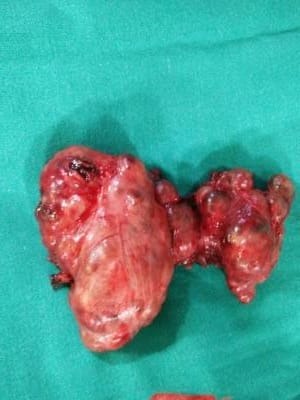
Thyroid gland cells are the only cells in the body that absorb and retain iodine. Iodine is needed to make thyroid hormones.
The thyroid is part of the body’s endocrine system, a system of glands that control hormones in the body. It normally weighs less than an ounce, and it cannot be seen or felt in most people; however it has an important function. The thyroid makes hormones that help regulate the body’s heart rate, blood pressure, temperature and metabolism (the breakdown of food to create energy).
Papillary Thyroid Cancer: Papillary Thyroid Cancer is the most common type of thyroid cancer, accounting for about 80% of thyroid cancers. While papillary thyroid cancer typically occurs in only one lobe of the thyroid gland, it may arise in both lobes in up to 10% to 20% of cases. Papillary thyroid cancer is most common in women of childbearing age. It sometimes is caused by exposure to radiation. Even though papillary thyroid cancer is usually not an aggressive type of cancer, it often metastasizes (spreads) to the lymph nodes in the neck. Papillary thyroid cancer treatment usually is successful.
Follicular Thyroid Cancer: Follicular thyroid cancer accounts for about 10% of thyroid cancers. Like papillary thyroid cancer, follicular thyroid cancer usually grows slowly. Its outlook is similar to papillary cancer, and its treatment is the same.This kind of thyroid cancer usually stays in the thyroid gland but sometimes spreads to other parts of the body, such as the lungs or bone. However, it usually does not spread to lymph nodes. It is more common in countries where diets do not contain enough iodine. Hurthle cell carcinoma, also called oxyphil cell carcinoma, is a type of follicular thyroid cancer. Most patients diagnosed with Hurthle cell cancer do well, but the outlook may change based on the extent of disease at the time of diagnosis.Follicular thyroid cancer
Medullary Thyroid Cancer: MTC is the only type of thyroid cancer that develops in the parafollicular cells of the thyroid gland. It accounts for 3% to 10% of thyroid cancers. Medullary thyroid cancer cells usually make and release into the blood proteins called calcitonin and/or carcinoembryonic antigen, which can be measured and used to follow the response to treatment for the disease. Sometimes medullary thyroid cancer spreads to the lymph nodes, lungs or liver before a nodule is found or the patient has symptoms. MTC can be treated more successfully if it is diagnosed before it has spread.
Anaplastic Thyroid Cancer: Anaplastic thyroid cancer is the most dangerous form of thyroid cancer. It is makes up only 1% of thyroid cancers. It is believed that anaplastic thyroid cancer grows from a papillary or follicular tumor that mutates further to this aggressive form. Anaplastic thyroid cancer spreads rapidly into areas such as the trachea, often causing breathing difficulties. Anaplastic thyroid cancer sometimes is called undifferentiated thyroid cancer because the cells are so different from normal thyroid tissue.
Scarless or Minimally invasive Thyroidectomy:This procedure is meant to perform half or total removal of thyroid gland by a technique which causes fewer scars in the neck or no visible scar in the neck.
There should be no previous surgeries in the same area of neck with nodule or thyroid size <=5cm, larger thyroid can also be removed with no visible scar but with combined approach (placing incision in the skin behind the ear and in the armpit)
Retroauricular approach in which incision is placed in area behind the ear and in the hairline so it is not visible, tunnel is created up to the thyroid lobe which is to be removed. The skin flap is held up with Chung’s retractor. Endoscope is introduced with for magnified view, specialised instruments are used to perform thyroidectomy (half or total removal of thyroid gland). Incision on other side may be required for removal of opposite thyroid. Special care is taken during surgery for identification of recurrent laryngeal nerve and its preservation, so that injury to this nerve is avoided. Parathyroid glands which are situated on the backside of thyroid lobe, control level of calcium in the body. These glands need to be preserved so that calcium levels are maintained in normal. For the utmost care during surgery we prefer ROBOTIC SURGERY (DAVINCI – XI) or ENDOSCOPIC SURGERY. Endoscopic surgery comes with the advantage of same approach with much decreased cost